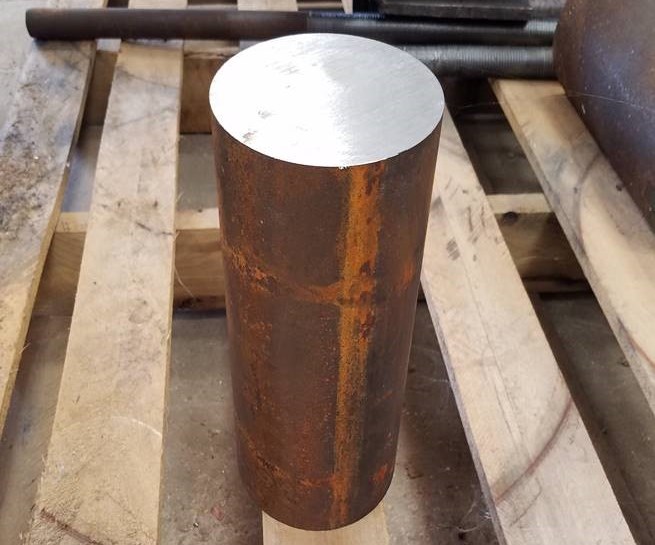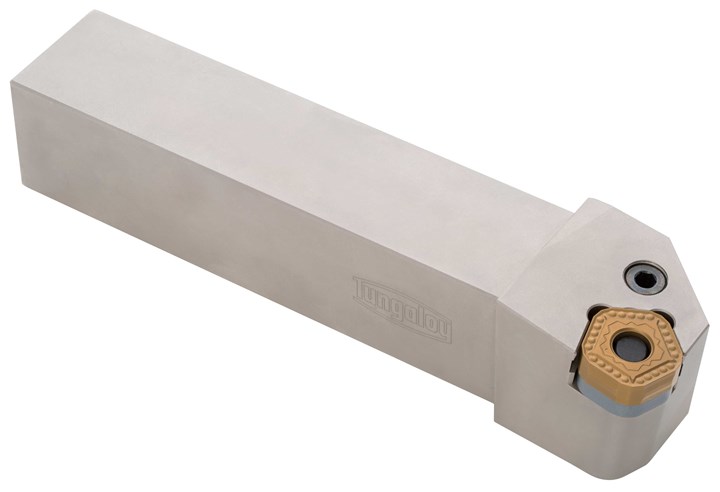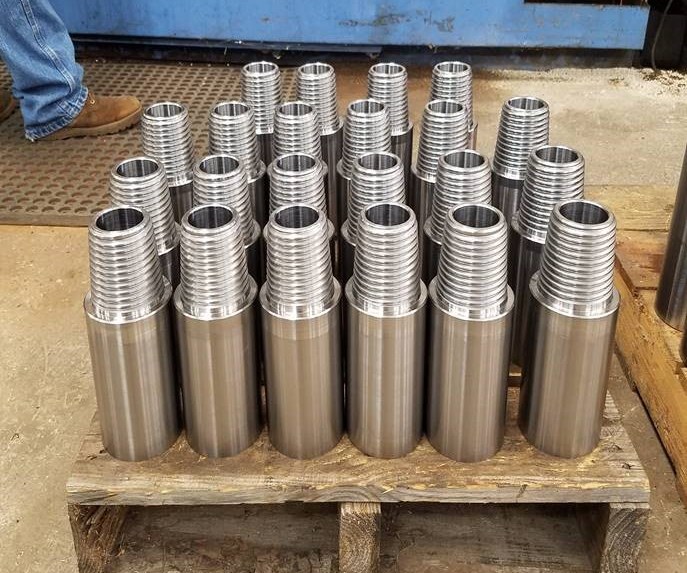Tool Improves Efficiency for Cutting 4140 Steel
Switching from a cutting tool insert that produced 24 parts per cutting edge to one that produces 40 parts per cutting edge saved a shop time and money.
Shops deal with different types of material, each with their own challenges. One material that can present some difficulties is 4140 steel. This material can have a tough crust or scale on the outside that is tough to machine and can wear down cutting tools quickly. However, special cutting tools can ease this process. For a shop in Mississippi, switching to a more efficient and economical tool from Tungaloy increased the number of parts it can produce per insert, saving time and money.

Helanbak machines 4140 steel into connectors for drill pipes. The material has a tough crust, or scale on the outside that is difficult to machine.
Helanbak got its start five years ago. The company’s owner, Kristian Agoglia, had come to the Columbia, Mississippi, area to clean up in the aftermath of Hurricane Katrina. The equipment he was using, including trimmers and clippers, had blades that needed to be sharpened. He took them to a local company called Terry’s Bits, which was owned by Randall Terry. Mr. Terry and Mr. Agoglia became friends, and eventually decided to go into business together.
The core of Helanbak’s business is drill pipes, which are used to drill holes in the ground off of drilling rigs for water well service, geological surveys and rock mining. This accounts for about 70% of the company’s business. It also produces firearms and does other precision machining work. The 10-employee company has a range of equipment to complete this work, including a friction welder, three Mazak Quick Turns, a Mazak VTC, Haas VF-4 Superspeeds, two Okuma lathes and a Doosan-Daewoo HBL-06 lathe.

The drill pipe connectors are machined on a Doosan HBL-06 lathe. The company had been using a CNMG insert with four cutting edges, each of which could produce 24 parts.
In addition to machining the drill pipes themselves, the company also produces connectors for the pipes, which it calls boxes and pins. These connectors are machined from 4140 steel on the Doosan lathe and then welded to the pipes. Machining these parts requires OD turning to remove the crust, or scale from the outside of the material. According to Production Manager Jennings Freeman, this is the biggest challenge of making these parts. “It’s really hard. It’s harder than the material itself,” he says. “It’s kind of like silica—sandy, gritty.”
The material is rough on cutting tool inserts. “It burns up the tool pretty bad,” Mr. Jennings says. The company was using Tungaloy CNMG 432 inserts with four cutting edges to machine these parts. With the tough crust on the outside of the material, each cutting edge could produce 24 parts. The company was going through a lot of inserts and spending a significant amount of time changing the cutting edges and inserts.
A new solution came to Mr. Freeman’s attention thanks to the company’s Tungaloy representative. “I have a good relationship with my Tungaloy rep. I’ve known him for a long time,” he says. “Anything he wants to try, he knows he can run it in here.”

At the suggestion of its Tungaloy sales rep, Helanbak switched out the CNMG inserts for TurnTen-Feed inserts in a high-feed holder. The double-sided insert has 10 cutting edges and can attain 0.079 inch (2 mm) of feed per revolution.
The product the rep wanted to try was the TurnTen-Feed insert. The insert is designed to be an efficient and economical solution for medium and heavy turning operations. It is available with two types of holders: an HD holder for high depths of cut, or an HF holder for high feed turning. According to the company, the HD holder enables depths of cut ranging to 0.276 inch (7 mm), and the HF holder can attain 0.079 inch (2 mm) of feed per revolution. The insert is double-sided, with a total of 10 cutting corners for cost efficiency. It also has an MNW-style chipbreaker with protrusions on the rake face to facilitate smooth chip control while achieving high crater wear resistance. Lever lock and dovetail clamping help ensure secure insert retention while promoting smooth chip flow, and a flat wiper is built into the cutting edge to achieve good machining surfaces at higher feed rates.

The TurnTen-Feed insert has enabled the company to increase the number of parts produced per cutting edge from 24 to 40. This, combined with the increase in cutting edges per insert from four to 10, means the company uses fewer inserts, which saves time and money.
According to Mr. Freeman, the TurnTen-Feed inserts were easy to implement. When compared with the previous CNMG 432 inserts, the new inserts were “a little bit different, but we just added a pass to take the crust off,” he says.
By using the new insert along with the HF holder, the shop was able to see a range of improvements:
- Increased productivity. “It was way faster,” Mr. Freeman notes. To be precise, metal removal rates (MRR) were four times faster with the TurnTen-Feed inserts than when they were using the CNMG inserts, increasing productivity.
- Increased feed rates. According to a test comparing the two inserts, the new insert enabled feed rates that were 6.25 times faster than the feed rates with the old insert.
- More parts per cutting edge. The TurnTen-Feed inserts are also more durable than the CNMG inserts. “If it was worse material, with a tougher crust, it didn’t affect the tool near as much as it did the CNMG,” Mr. Freeman notes. Whereas the CNMG inserts could produce 24 parts per cutting edge, the TurnTen-Feed inserts could produce 40 parts per cutting edge. This saves time, as the company does not need to change inserts as frequently as it did with the CNMG inserts.
- Reduced costs. The doubled-sided TurnTen-Feed inserts have a total of 10 cutting edges, which is six more than the four cutting edges the CNMG inserts had. “I used way less of those tools than I did the CNMG,” Mr. Freeman says. The increased number of parts per cutting edge, combined with the increased number of cutting edges per insert means the company is using fewer inserts and spending less money.
- More reliable. Mr. Freeman adds that he felt he could trust the new TurnTen-Feed inserts more than the previous inserts. “I was more confident in that tool taking the crust off than the other tool, because sometimes it would go out halfway through,” he says. Because of this increased confidence, he was able to accomplish other tasks while the machine ran. “You could walk away from it a little easier,” he says. “You could go run another machine and keep an ear on it. It was more reliable. I didn’t have to worry about it.”
Tungaloy America Inc. | 800-542-3222 | tungaloy.com/us
Helanbak | 601-739-6112 | helanbak.com
RELATED CONTENT
-
Tools and Technologies for Deep Hole Drilling
Understanding the challenges of deep hole drilling and knowing how to select and apply the appropriate tools will help a shop profit from this operation.
-
When Thread Milling Makes Sense
Threading a workpiece is a fundamental metalworking process that every manufacturing engineer takes for granted.
-
4 Strategies for Managing Chip Control
Having strategies in place for managing chips is an important part of protecting the production process, from tool life to product quality.



